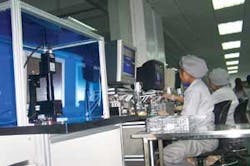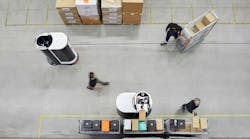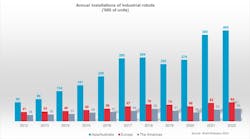A discussion with Ding Shaohua of Second2None Machine Vision Systems
VSD: What is the mission of Second2None Machine Vision Systems? Which industries do you serve?
Ding: We strive to become a recognized automation-solution provider meeting international standards and supplying reliable products and quality services to our customers worldwide. Basically, we supply vision-based machines to general manufacturing industries. For example, we make noncontact, high-precision measuring systems for manufacturers of precision parts and inspection systems for fuse manufacturers. In addition, we provide solutions for applications such as vision-based alignment and surface inspection for OEM customers in the semiconductor and electronics industries. These customers make die and wire bonders, tapping machines, chip-on-glass machines, and printing machines.
VSD: Would you describe how machine vision is being implemented in Chinese industrial processes?
Ding: At present, manufacturers in China that can afford machine-vision technology in their products or processes are mostly leaders in their respective industries. They have financial strength and scale. Most of them have their own engineering teams that are responsible for developing equipment for their industrial processes. With the company’s financial support, the team feels no constraints in hiring the best engineering staff and can afford expensive vision components. Although the company management may hope that its engineering teams can perform R&D, often this is outsourced to professional system integrators.
VSD: What is it like for machine-vision system integrators in China?
Ding: In one word, tough! Compared with their foreign counterparts, Chinese customers are more demanding. In most cases, they are willing to pay much less for a custom design. If the client is familiar with machine-vision technology and understands the benefits of implementing it, then system integrators can expect a reasonable deal. Otherwise, the business is much harder for system integrators.
Normally, many stages of system development are necessary before a purchase order is received. First, we must understand customer requirements, then write and confirm these specifications, and then produce a feasibility study, technical plan, experiment and demonstration, quotation, and bargaining before a purchase order is issued and the project starts. Usually this is a lengthy process and price plays a critical role.
One of my colleagues recently joked: “When I first discussed the project with this customer, I had just met the woman who would become my wife. By the time I got the contract from him, my wife and I had a baby who could call me ‘daddy’. Everything calculated, the profit was only 4.6 yuan in total!” [about US$0.50].
VSD: What are end users demanding from Second2None in the design of new systems?
Ding: We recently completed a project on measuring mechanical parts. The customer demanded a GRnR of <10%, and a correlation index greater than 80% using a SmartScope from Optical Gaging Products (Rochester, NY, USA; www.ogpnet.com), a pin gauge, and a coordinate-measuring machine [CMM]. The GRnR test was easily passed. The correlation with SmartScope was greater than 90%, which also easily passed. But because vision-based gauge data are not easily correlated with CMM or pin gauge, we had to make a lot of changes to the software just to get the gauging algorithm to simulate that of a CMM and pin gauge.
The customer is called “king” in the commercial world, and customers have the most advantageous position. System integrators must change to their customer’s needs. In a situation in which either party could change to adapt, it is always the system integrator that changes.
VSD: What technologies and components do you use in your applications?
Ding: So far we have created a large number of machine-vision solutions and equipment, most of which are PC-based. For these applications, application development is based on Adept Technology (Livermore, CA, USA; www.adept.com) HexSight. This vision software development kit is among the best of its kind and has outstanding features in terms of accuracy, speed, and robustness. We are also the authorized distributor and system integrator of HexSight in China.
Recently we became a partner with PPT Vision (Eden Prairie, MN, USA; www.pptvision.com). In smart camera-based projects we use the PPT Vision Impact T series. These products are fast and reliable, which make them suitable for high-speed inspection.
For cameras, we use Costar CCDs cameras from Voltrium Systems (Singapore; www.voltrium.com.sg); for illumination, we use Oriental System Engineering (Singapore; www.osesemi.com/oriental.htm) LED lighting.
VSD: What could vision-equipment manufacturers do to make your job easier?
Ding: Just like end users, we are demanding, too. Here are some pointers from our team:
Product
- Vision equipment manufacturers must provide a product with a high performance-to-price ratio; the product must be of good quality, reliable, nicely packaged, and the price must be lower than their competitors
- The product must be easy to use
- The product should have reliable interfaces and compatibility with existing standards
- Custom design service should be available from equipment manufacturers.
Service
- Good after-sale service and warranty terms
- Full product line
- Good technical support and prompt reply to enquiries and questions
- Rich pool of case studies to guide our application development.
Marketing
- Stable pricing policy with a big discount to us
- Good brand awareness for end users
- Always forward sales leads to us to increase our business.
Partnership
- Offer a strategic partnership to share information and resources. PPT Vision, for example, has a good partnership program.
VSD: In which industries and geographic areas do you see the most growth?
Ding: In China, especially South China, general manufacturing has the biggest potential for machine-vision applications. China is becoming the world’s factory. In current manufacturing processes, zero-defect and 100% inspection are becoming the norm. Many inspection jobs can only be performed by machines rather than human beings. On the other hand, as labor cost in China increases and technology cost decreases, machine vision will find more and more applications in various manufacturing sectors.
VSD: What new applications and sectors do you expect to emerge? What new software, components, and systems will be needed?
Ding: Vision-guided robots will be used in the mining industry to dig coal. Intelligent monitoring will help increase productivity and decrease the occurrence of mine accidents. Besides this, intelligent public surveillance, 3-D localization, and color recognition will find many applications. Software, especially localization and color analysis software, high-resolution and high-frame rate cameras, cameras designed for special purposes, and general-purpose platforms that integrate machine vision and motion control will find many opportunities.
DING SHAOHUA is managing director of Second2None Machine Vision Systems (Shenzhen, China; www.visiondragon.com), which he founded in 2002. He has a B.S. and M.Sc. in E&E from Wuhan University of Science and Technology and a Ph.D. in Mechatronics from Huazhong University of Science and Technology. Ding has years of experience working and teaching in Great Britain, the USA, and Singapore. Editor in chief Conard Holton talked to him about the machine-vision industry in China.







